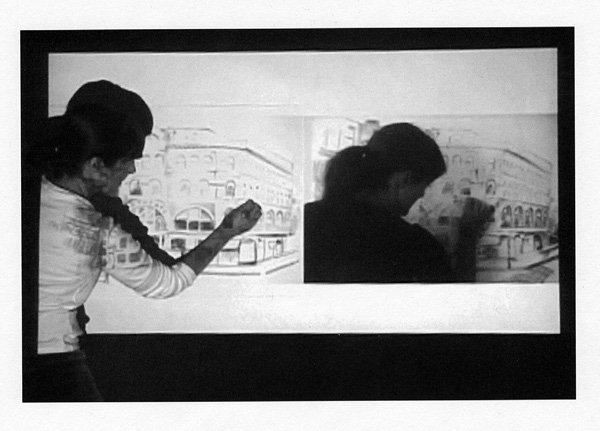
DEMOLITION
first performed on April 27, 2012
Low Lives 4, International Internet Performance Art Festival, broadcast into: Center for Performance Research, Brooklyn, NY, Real Art Ways, Hartford, CT, Portland Institute for Contemporary Art, Portland, OR and Dimanche Rouge, Paris, France
performed twice in 2012
ELIZABETH LEISTER
Los Angeles, CA
elizabethleister.com
DEMOLITION
ELIZABETH LEISTER
“Demolition” is based on a time-lapse video, from 1902, of the Starr Theatre in New York City. As the architectural structure is demolished brick by brick over what is assumed to be a 30-day period, it slowly disappears. One of the first time-lapse films, it demonstrated a powerful and magical collapse of time and form.
“Demolition” was conceived as a live-transmission performance. The drawing and video described below were framed as a transmitted image, projected and experienced live in multiple venues simultaneously.
I created a time-lapse video of a drawing of the Starr Theatre based on the video footage. Once the drawing of the Starr Theatre was complete, I erased it.
In the performance the time-lapse drawing and the video of the erasure are projected side by side. The time-lapse drawing is reversed so that it begins as an image and slowly disappears. I enter into the projection and draw over the time-lapse drawing to generate a new drawing of the Starr Theatre. Once it is complete, it is erased.
In the end, my real body and video body exit the framed projection. The digital image fades and faint graphite marks remain as a trace of my hand and the drawn form. Private and public space, the real and the virtual body, absence and presence are underscored through the physicality of drawing and by contrast the clean, digital mark of light—subject to the whims of delay, degradation and disappearance.
Broadcasting real-time into places I have never been, for people who I may never meet, is strangely exhilarating. It explodes the spatial and temporal limitations of traditional performance. This distance from the audience can be challenging logistically while simultaneously permitting a degree of freedom inside the safety of my private studio. The absence of an energetic connection to a live audience is a significant difference from traditional forms. Technology affords this interaction where proximity and distance, time and place, overlap and transform into a dynamic space, neither here nor there, now or then.